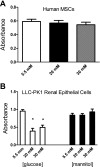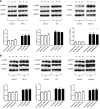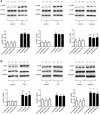High glucose concentration in cell culture medium does not acutely affect human mesenchymal stem cell growth factor production or proliferation
- PMID: 19386985
- PMCID: PMC2692791
- DOI: 10.1152/ajpregu.90876.2008
High glucose concentration in cell culture medium does not acutely affect human mesenchymal stem cell growth factor production or proliferation
Abstract
Optimizing the function and proliferative capacity of stem cells is essential to maximize their therapeutic benefits. High glucose concentrations are known to have detrimental effects on many cell types. We hypothesized that human mesenchymal stem cells (hMSCs) cultured in high glucose-containing media would exhibit diminished proliferation and attenuated production of VEGF, hepatocyte growth factor (HGF), and FGF2 in response to treatment with TNF-alpha, LPS, or hypoxia. hMSCs were plated in medium containing low (5.5 mM) and high (20 mM or 30 mM) glucose concentrations and treated with TNF-alpha, LPS, or hypoxia. Supernatants were collected at 24 and 48 h and assayed via ELISA for VEGF, HGF, and FGF2. In addition, hMSCs were cultured on 96-well plates at the above glucose concentrations, and proliferation at 48 h was determined via bromo-2'-deoxy-uridine (BrdU) incorporation. At 24 and 48 h, TNF-alpha, LPS, and hypoxia-treated hMSCs produced significantly higher VEGF, HGF, and FGF2 compared with control. Hypoxia-induced VEGF production by hMSCs was the most pronounced change over baseline. At both 24 and 48 h, glucose concentration did not affect production of VEGF, HGF, or FGF2 by untreated hMSCs and those treated with TNF-alpha, LPS, or hypoxia. Proliferation of hMSCs as determined via BrdU incorporation was unaffected by glucose concentration of the media. Contrary to what has been observed with other cells, hMSCs may be resistant to the short-term effects of high glucose. Ongoing efforts to characterize and optimize ex vivo and in vivo conditions are critical if the therapeutic benefits of MSCs are to be maximized.
Figures








Similar articles
-
Human mesenchymal stem cells stimulated by TNF-alpha, LPS, or hypoxia produce growth factors by an NF kappa B- but not JNK-dependent mechanism.Am J Physiol Cell Physiol. 2008 Mar;294(3):C675-82. doi: 10.1152/ajpcell.00437.2007. Epub 2008 Jan 30. Am J Physiol Cell Physiol. 2008. PMID: 18234850
-
Human progenitor cells from bone marrow or adipose tissue produce VEGF, HGF, and IGF-I in response to TNF by a p38 MAPK-dependent mechanism.Am J Physiol Regul Integr Comp Physiol. 2006 Oct;291(4):R880-4. doi: 10.1152/ajpregu.00280.2006. Epub 2006 May 25. Am J Physiol Regul Integr Comp Physiol. 2006. PMID: 16728464
-
Mesenchymal stem cells enhance the viability and proliferation of human fetal intestinal epithelial cells following hypoxic injury via paracrine mechanisms.Surgery. 2009 Aug;146(2):190-7. doi: 10.1016/j.surg.2009.03.031. Surgery. 2009. PMID: 19628073
-
Nitric oxide suppresses the secretion of vascular endothelial growth factor and hepatocyte growth factor from human mesenchymal stem cells.Shock. 2008 Nov;30(5):527-31. doi: 10.1097/SHK.0b013e31816f1ec9. Shock. 2008. PMID: 18391852
-
Human Mesenchymal Stem Cell Hydrogen Sulfide Production Critically Impacts the Release of Other Paracrine Mediators After Injury.J Surg Res. 2020 Oct;254:75-82. doi: 10.1016/j.jss.2020.04.014. Epub 2020 May 15. J Surg Res. 2020. PMID: 32417499 Free PMC article.
Cited by
-
Accelerated cerebral vascular injury in diabetes is associated with vascular smooth muscle cell dysfunction.Geroscience. 2020 Apr;42(2):547-561. doi: 10.1007/s11357-020-00179-z. Epub 2020 Mar 12. Geroscience. 2020. PMID: 32166556 Free PMC article.
-
TLR4 inhibits mesenchymal stem cell (MSC) STAT3 activation and thereby exerts deleterious effects on MSC-mediated cardioprotection.PLoS One. 2010 Dec 3;5(12):e14206. doi: 10.1371/journal.pone.0014206. PLoS One. 2010. PMID: 21151968 Free PMC article.
-
Neurodifferentiation and Neuroprotection Potential of Mesenchymal Stromal Cell-Derived Secretome Produced in Different Dynamic Systems.Biomedicines. 2023 Apr 22;11(5):1240. doi: 10.3390/biomedicines11051240. Biomedicines. 2023. PMID: 37238911 Free PMC article.
-
A Comparison of the Preservation of Mouse Adipose Tissue-Derived Mesenchymal Stem Cells Using the University of Wisconsin Solution and Hank's Balanced Salt Solution.Stem Cells Int. 2018 Sep 6;2018:1625464. doi: 10.1155/2018/1625464. eCollection 2018. Stem Cells Int. 2018. PMID: 30258463 Free PMC article.
-
Low-glucose culture environment can enhance the wound healing capability of diabetic adipose-derived stem cells.Stem Cell Res Ther. 2023 Sep 4;14(1):236. doi: 10.1186/s13287-023-03478-2. Stem Cell Res Ther. 2023. PMID: 37667384 Free PMC article.
References
-
- Allen DA, Harwood S, Varagunam M, Raftery MJ, Yaqoob MM. High glucose-induced oxidative stress causes apoptosis in proximal tubular epithelial cells and is mediated by multiple caspases. FASEB J 17: 908–910, 2003. - PubMed
-
- Assmus B, Schachinger V, Teupe C, Britten M, Lehmann R, Dobert N, Grunwald F, Aicher A, Urbich C, Martin H, Hoelzer D, Dimmeler S, Zeiher AM. Transplantation of Progenitor Cells and Regeneration Enhancement in Acute Myocardial Infarction (TOPCARE-AMI). Circulation 106: 3009–3017, 2002. - PubMed
-
- Burt RK, Loh Y, Pearce W, Beohar N, Barr WG, Craig R, Wen Y, Rapp JA, Kessler J. Clinical applications of blood-derived and marrow-derived stem cells for nonmalignant diseases. JAMA 299: 925–936, 2008. - PubMed
-
- Cai L, Johnstone BH, Cook TG, Liang Z, Traktuev D, Cornetta K, Ingram DA, Rosen ED, March KL. Suppression of hepatocyte growth factor production impairs the ability of adipose-derived stem cells to promote ischemic tissue revascularization. Stem Cells 25: 3234–3243, 2007. - PubMed
-
- Chang C, Wang X, Niu D, Zhang Z, Zhao H, Gong F. Mesenchymal stem cells adopt beta-cell fate upon diabetic pancreatic microenvironment. Pancreas 38: 275–81, 2009. - PubMed
Publication types
MeSH terms
Substances
Grants and funding
LinkOut - more resources
Full Text Sources
Other Literature Sources

